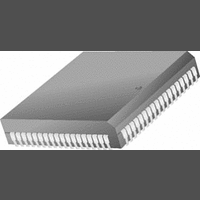MC68EC000EI8 Freescale Semiconductor, MC68EC000EI8 Datasheet - Page 29

MC68EC000EI8
Manufacturer Part Number
MC68EC000EI8
Description
IC MPU 32BIT 85MHZ 68-PLCC
Manufacturer
Freescale Semiconductor
Series
M68000r
Specifications of MC68EC000EI8
Processor Type
M680x0 32-Bit
Speed
8MHz
Voltage
3.3V, 5V
Mounting Type
Surface Mount
Package / Case
68-PLCC
Core Size
32 Bit
Cpu Speed
8MHz
Digital Ic Case Style
PLCC
No. Of Pins
68
Supply Voltage Range
3V To 3.6V
Operating Temperature Range
0°C To +70°C
Filter Terminals
SMD
Rohs Compliant
Yes
Clock Frequency
8MHz
Lead Free Status / RoHS Status
Lead free / RoHS Compliant
Features
-
Available stocks
Company
Part Number
Manufacturer
Quantity
Price
Company:
Part Number:
MC68EC000EI8
Manufacturer:
XILINX
Quantity:
661
Company:
Part Number:
MC68EC000EI8
Manufacturer:
Freescale Semiconductor
Quantity:
10 000
Company:
Part Number:
MC68EC000EI8R2
Manufacturer:
Freescale Semiconductor
Quantity:
10 000
- Current page: 29 of 646
- Download datasheet (3Mb)
Introduction
1.6.1 Normalized Numbers
Normalized numbers encompass all numbers with exponents laying between the maximum
and minimum values. Normalized numbers can be positive or negative. For normalized
numbers in single and double precision the implied integer bit is one. In extended precision,
the mantissa’s MSB, the explicit integer bit, can only be a one (see Figure 1-13); and the
exponent can be zero.
1.6.2 Denormalized Numbers
Denormalized numbers represent real values near the underflow threshold. The detection
of the underflow for a given data format and operation occurs when the result’s exponent is
less than or equal to the minimum exponent value. Denormalized numbers can be positive
or negative. For denormalized numbers in single and double precision the implied integer
bit is a zero. In extended precision, the mantissa’s MSB, the explicit integer bit, can only be
a zero (see Figure 1-14).
Traditionally, the detection of underflow causes floating-point number systems to perform a
"flush-to-zero". This leaves a large gap in the number line between the smallest magnitude
normalized number and zero. The IEEE 754 standard implements gradual underflows: the
result mantissa is shifted right (denormalized) while the result exponent is incremented until
reaching the minimum value. If all the mantissa bits of the result are shifted off to the right
during this denormalization, the result becomes zero. Usually a gradual underflow limits the
potential underflow damage to no more than a round-off error. This underflow and
denormalization description ignores the effects of rounding and the user-selectable
rounding modes. Thus, the large gap in the number line created by "flush-to-zero" number
systems is filled with representable (denormalized) numbers in the IEEE "gradual
underflow" floating-point number system.
Since the extended-precision data format has an explicit integer bit, a number can be
formatted with a nonzero exponent, less than the maximum value, and a zero integer bit.
The IEEE 754 standard does not define a zero integer bit. Such a number is an
unnormalized number. Hardware does not directly support denormalized and unnormalized
numbers, but implicitly supports them by trapping them as unimplemented data types,
allowing efficient conversion in software.
1-18
M68000 FAMILY PROGRAMMER’S REFERENCE MANUAL
SIGN OF MANTISSA, 0 OR 1
MIN < EXPONENT < MAX
SIGN OF MANTISSA, 0 OR 1
Figure 1-14. Denormalized Number Format
Figure 1-13. Normalized Number Format
EXPONENT = 0
MANTISSA = ANY NONZERO BIT PATTERN
.
.
MANTISSA = ANY BIT PATTERN
MOTOROLA
Related parts for MC68EC000EI8
Image
Part Number
Description
Manufacturer
Datasheet
Request
R
Part Number:
Description:
Manufacturer:
Freescale Semiconductor, Inc
Datasheet:
Part Number:
Description:
Manufacturer:
Freescale Semiconductor, Inc
Datasheet:
Part Number:
Description:
Manufacturer:
Freescale Semiconductor, Inc
Datasheet:
Part Number:
Description:
Manufacturer:
Freescale Semiconductor, Inc
Datasheet:
Part Number:
Description:
Manufacturer:
Freescale Semiconductor, Inc
Datasheet:
Part Number:
Description:
Manufacturer:
Freescale Semiconductor, Inc
Datasheet:
Part Number:
Description:
Manufacturer:
Freescale Semiconductor, Inc
Datasheet:
Part Number:
Description:
Manufacturer:
Freescale Semiconductor, Inc
Datasheet:
Part Number:
Description:
Manufacturer:
Freescale Semiconductor, Inc
Datasheet:
Part Number:
Description:
Manufacturer:
Freescale Semiconductor, Inc
Datasheet:
Part Number:
Description:
Manufacturer:
Freescale Semiconductor, Inc
Datasheet:
Part Number:
Description:
Manufacturer:
Freescale Semiconductor, Inc
Datasheet:
Part Number:
Description:
Manufacturer:
Freescale Semiconductor, Inc
Datasheet:
Part Number:
Description:
Manufacturer:
Freescale Semiconductor, Inc
Datasheet:
Part Number:
Description:
Manufacturer:
Freescale Semiconductor, Inc
Datasheet:











